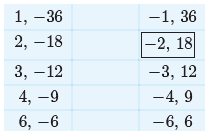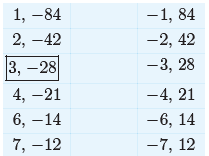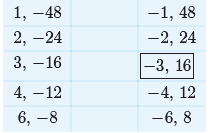Zeros of the Quadratic
We’ve seen how vertex form and intelligent use of the axis
of symmetry can help to draw
an accurate graph of the quadratic function defined by the equation f(x) =
ax2+bx+c.
When drawing the graph of the parabola it is helpful to know where the graph of
the
parabola crosses the x-axis. That is the primary goal of this section, to find
the zero
crossings or x-intercepts of the parabola.
Before we begin, you’ll need to review the techniques that will enable you to
factor
the quadratic expression ax2 + bx + c.
Factoring ax2 + bx + c when a = 1
Our intent in this section is to provide a quick review of techniques used to
factor
quadratic trinomials. We begin by showing how to factor trinomials having the
form
ax2 + bx + c, where the leading coefficient is a = 1; that is, trinomials having
the form
x2+bx+c. In the next section, we will address the technique used to factor
ax2+bx+c
when a ≠ 1.
Let’s begin with an example.
 Example 1. Factor x2 + 16x − 36.
Example 1. Factor x2 + 16x − 36.
Note that the leading coefficient, the coefficient of x2, is a 1. This is an
important
observation, because the technique presented here will not work when the leading
coefficient does not equal 1.
Note the constant term of the trinomial x2 +16x−36 is −36. List all integer
pairs
whose product equals −36.

Note that we’ve framed the pair −2, 18. We’ve done this
because the sum of this
pair of integers equals the coefficient of x in the trinomial expression x2 +
16x − 36.
Use this framed pair to factor the trinomial.
x2 + 16x − 36 = (x − 2)(x + 18)
It is important that you check your result. Use the distributive property to
multiply.
(x − 2)(x + 18) = x(x + 18) − 2(x + 18)
= x2 + 18x − 2x − 36
= x2 + 16x − 36
Thus, our factorization is correct.
Let’s summarize the technique.
| Algorithm. To factor the quadratic x2 + bx + c,
proceed as follows: 1. List all the integer pairs whose product equals c. 2. Circle or frame the pair whose sum equals the coefficient of x, namely b. Use this pair to factor the trinomial. |
Let’s look at another example.
![]() Example 2. Factor the trinomial x2 − 25x − 84.
Example 2. Factor the trinomial x2 − 25x − 84.
List all the integer pairs whose product is −84.

We’ve framed the pair whose sum equals the coefficient of
x, namely −25. Use this
pair to factor the trinomial.
x2 − 25x − 84 = (x + 3)(x − 28)
Check.
(x + 3)(x − 28) = x(x − 28) + 3(x − 28)
= x2 − 28x + 3x − 84
= x2 − 25x − 84
With experience, there are a number of ideas that will quicken the process.
• As you are listing the integer pairs, should you happen to note that the
current
pair has the appropriate sum, there is no need to list the remaining integer
pairs.
Simply halt the process of listing the integer pairs and use the current pair to
factor
the trinomial.
• Some students are perfectly happy being asked “Can you think of an integer
pair
whose product is c and whose sum is b (where b and c refer to the coefficients
of
x2+bx+c)?” If you can pick the pair “out of the air” like this, all is well and
good.
Use the integer pair to factor the trinomial and don’t
bother listing any integer
pairs.
Now, let’s investigate how to proceed when the leading coefficient is not 1.
Factoring ax2 + bx + c when a ≠ 1
When a ≠ 1, we use a technique called the ac-test to factor the trinomial ax2
+bx+c.
The process is best explained with an example.
![]() Example 3. Factor 2x2 + 13x − 24.
Example 3. Factor 2x2 + 13x − 24.
Note that the leading coefficient does not equal 1. Indeed, the coefficient of
x2 in
this example is a 2. Therefore, the technique of the previous examples will not
work.
Thus, we turn to a similar technique called the ac-test.
First, compare
2x2 + 13x − 24 and ax2 + bx + c
and note that a = 2, b = 13, and c = −24. Compute the product of a and c. This
is
how the technique earns its name “ac-test.”
ac = (2)(−24) = −48
List all integer pairs whose product is ac = −48.

We’ve framed the pair whose sum is b = 13. The next step
is to rewrite the trinomial
2x2 + 13x − 24, splitting the middle term into a sum, using our framed integer
pair.
2x2 + 13x − 24 = 2x2 − 3x + 16x − 24
We factor an x out of the first two terms, then an 8 out of the last two terms.
This
process is called factoring by grouping.
2x2 − 3x + 16x − 24 = x(2x − 3) + 8(2x − 3)
We now factor out a common factor of 2x − 3.
x(2x − 3) + 8(2x − 3) = (x + 8)(2x − 3)
It’s helpful to see the complete process as a coherent unit.
2x2 + 13x − 24 = 2x2 − 3x + 16x − 24
= x(2x − 3) + 8(2x − 3)
= (x + 8)(2x − 3)
Check. Again, it is important to check the answer by multiplication.
(x + 8)(2x − 3) = x(2x − 3) + 8(2x − 3)
= 2x2 − 3x + 16x − 24
= 2x2 + 13x − 24
Because this is the original trinomial, our solution checks.
Let’s summarize this process.
| Algorithm: ac-Test. To factor the quadratic ax2 +
bx + c, proceed as follows: 1. List all integer pairs whose product equals ac. 2. Circle or frame the pair whose sum equals the coefficient of x, namely b. 3. Use the circled pair to express the middle term bx as a sum. 4. Factor by “grouping.” |
Let’s look at another example.

